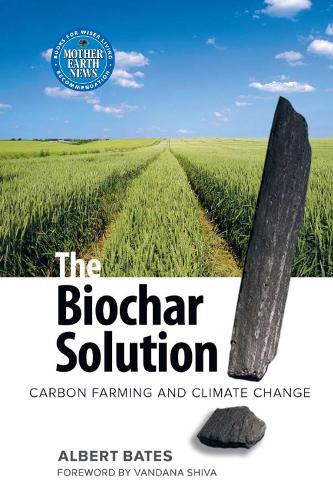
The Biochar Solution: Carbon Farming and Climate Change
(Paperback)
Publishing Details
The Biochar Solution: Carbon Farming and Climate Change
By (Author) Albert K. Bates
New Society Publishers
New Society Publishers
19th January 2011
United States
Classifications
Professional and Scholarly
Non Fiction
631.58
Physical Properties
Paperback
208
Width 152mm, Height 229mm, Spine 11mm
345g
Description
How the dirt below our feet can save us from extinction
Reviews
Review BioScience Magazine, October 2011
For those who are not scientists directly involved with biochar, this is a book worth reading. It presents the science that got biochar rolling, the technologies already available, and how to use it to enhance food security and restore degraded agroecosystems. It is well designed for international agricultural aid staff, nongovernmental organization activists, and agricultural extensionists. Anyone interested in climate change mitigation and adaptation will gain something from this book, because Bates is careful to point out that mitigation and adaptation will only succeed if global society decides to change the ways it thinks about population and consumption.
BioScience, Vol. 61, No. 10 (October 2011), pp. 831-833
University of California Press on behalf of the American Institute of Biological Sciences
May 2011 CHOICE
The basic premise of this book is that the carbon cycle must be balanced for a healthy planet. To prove this idea, Bates, an instructor and writer (Climate in Crisis, 1990; The Post-Petroleum Survival Guide and Cookbook, 2006), claims that when ancient Amazonian civilizations collapsed, rain forests engulfed the cities and roads. Archaeologists and historians are still puzzled about the reasons for the demise of these Amazonian empires. Bates asserts that starting around the ninth century, Europe began growing colder due to massive sequestering of carbon from the atmosphere by these new immense Amazonian forests. He examines several techniques for combating global warming, such as using biochar and less destructive tilling techniques, and restraining global corporations that manufacture synthetic fertilizers and genetically modified seed stocks. The author also recommends massive tree planting and a change in cultural attitudes about how humans manage Earth's resources. One unique solution to global warming is to provide poor, rural third world people with biochar stoves that generate needed heat and produce biochar. Agricultural use of biochar would reduce carbon dioxide in the atmosphere and slow down global warming.
Summing Up: Recommended. All undergraduate students and general readers interested in biochar. -- K. Bennett, emeritus, Kalamazoo Valley Community College
Review BioScience Magazine, October 2011
For those who are not scientists directly involved with biochar, this is a book worth reading. It presents the science that got biochar rolling, the technologies already available, and how to use it to enhance food security and restore degraded agroecosystems. It is well designed for international agricultural aid staff, nongovernmental organization activists, and agricultural extensionists. Anyone interested in climate change mitigation and adaptation will gain something from this book, because Bates is careful to point out that mitigation and adaptation will only succeed if global society decides to change the ways it thinks about population and consumption.
BioScience, Vol. 61, No. 10 (October 2011), pp. 831-833
University of California Press on behalf of the American Institute of Biological Sciences
May 2011 CHOICE
The basic premise of this book is that the carbon cycle must be balanced for a healthy planet. To prove this idea, Bates, an instructor and writer (Climate in Crisis, 1990; The Post-Petroleum Survival Guide and Cookbook, 2006), claims that when ancient Amazonian civilizations collapsed, rain forests engulfed the cities and roads. Archaeologists and historians are still puzzled about the reasons for the demise of these Amazonian empires. Bates asserts that starting around the ninth century, Europe began growing colder due to massive sequestering of carbon from the atmosphere by these new immense Amazonian forests. He examines several techniques for combating global warming, such as using biochar and less destructive tilling techniques, and restraining global corporations that manufacture synthetic fertilizers and genetically modified seed stocks. The author also recommends massive tree planting and a change in cultural attitudes about how humans manage Earth's resources. One unique solution to global warming is to provide poor, rural third world people with biochar stoves that generate needed heat and produce biochar. Agricultural use of biochar would reduce carbon dioxide in the atmosphere and slow down global warming.
Summing Up: Recommended. All undergraduate students and general readers interested in biochar. -- K. Bennett, emeritus, Kalamazoo Valley Community College
Author Bio
Albert Bates was a delegate to the Copenhagen climate conference, trying to point the world back towards a stable atmosphere using soils and trees. His books include Climate in Crisis and The Post-Petroleum Survival Guide and Cookbook. Working with the Global Ecovillage Network he has taught appropriate technology, natural building and permaculture to students from more than sixty nations.
